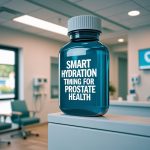Prostate health is often discussed in hushed tones, yet it impacts a significant portion of the male population, particularly as they age. Many men experience varying degrees of discomfort related to prostate issues – from frequent urination to urgency and even pain. While complex conditions require medical attention, simple lifestyle adjustments can play a crucial role in managing symptoms and promoting overall comfort. Among these adjustments, adequate hydration stands out not just as beneficial, but often essential. However, it’s not simply about drinking more water; it’s about thoughtfully portioning your daily intake to optimize prostate health and minimize irritating bladder signals. This article will delve into the nuances of daily water portioning for prostate comfort, offering practical strategies and insights.
The prostate gland, responsible for producing seminal fluid, is sensitive to inflammation and pressure. Dehydration can exacerbate these issues, leading to concentrated urine that irritates the bladder and surrounding tissues. Conversely, excessive fluid intake, especially in one go, can overwhelm the bladder and contribute to urgency. The key lies in finding a balance – a consistent, measured approach to hydration throughout the day. This isn’t about depriving yourself of fluids; it’s about smart hydration, tailored to support prostate health and minimize discomfort. It’s also important to remember that individual needs vary based on activity level, climate, diet, and underlying health conditions, making a personalized strategy paramount. Consider exploring strategies for balancing daily fluids to further support prostate well-being.
The Science Behind Hydration & Prostate Health
The connection between hydration and prostate comfort isn’t merely anecdotal; it stems from several physiological factors. A well-hydrated system allows for more dilute urine, reducing irritation to the sensitive tissues of the bladder and urethra. When you’re dehydrated, the kidneys conserve water, resulting in concentrated urine that can worsen symptoms associated with conditions like benign prostatic hyperplasia (BPH) or prostatitis. Think of it like this: imagine washing a delicate surface with either diluted soap or concentrated detergent – the latter is far more likely to cause irritation.
Furthermore, proper hydration aids in flushing out toxins and inflammatory compounds from the body. Chronic inflammation can contribute significantly to prostate discomfort, and staying adequately hydrated supports the natural detoxification processes. Beyond urine dilution, water helps maintain optimal kidney function, which plays a vital role in regulating fluid balance and preventing urinary tract infections – another potential source of discomfort for men with prostate issues. It’s also worth noting that consistent hydration is more important than large infrequent gulps; steady intake supports healthier bladder control. For additional support, you might explore alkaline water benefits for urinary tract health.
Finally, the impact extends to bowel health. Constipation can put additional pressure on the pelvic floor muscles and exacerbate prostate symptoms. Adequate water intake softens stool, promoting regular bowel movements and relieving this added strain. Maintaining a healthy digestive system contributes indirectly but significantly to overall pelvic comfort. To enhance your dietary approach, consider keeping a daily food diary to pinpoint potential triggers.
Portioning Your Daily Water Intake
The often-cited “eight glasses of water” rule is a good starting point, but it’s not universally applicable. A more personalized approach considers individual factors and focuses on consistent sipping throughout the day rather than large volumes at once. Aim for approximately half your body weight in ounces of water daily as a baseline – for example, a 180-pound man might aim for around 90 ounces. However, adjust this based on activity level, climate (hotter climates require more fluid), and dietary intake (foods with high water content contribute to hydration).
Instead of drinking large amounts at meals or before bed, spread your water intake evenly throughout the day. – Consider setting reminders on your phone or using a water bottle with time markers to encourage consistent sipping. – Avoid consuming significant quantities of fluids 2-3 hours before bedtime to minimize nighttime urination. – Pay attention to your body’s signals: thirst is an obvious indicator, but also observe urine color; pale yellow indicates good hydration, while dark yellow suggests you need more fluid. A simple strategy involves dividing your daily water goal into smaller, manageable portions – for example, 16-20 ounces every couple of hours. Learning about smart hydration timing can refine this process.
Remember to consider other beverages as well. While water is the ideal choice, herbal teas and diluted fruit juices can contribute to hydration. However, limit caffeinated drinks (coffee, tea, soda) and alcohol, as they have diuretic effects and can worsen bladder irritation. Also, be mindful of sodium intake; high sodium levels can lead to fluid retention and exacerbate prostate symptoms.
Optimizing Timing & Fluid Choices
Timing is crucial when it comes to water portioning for prostate comfort. As mentioned earlier, avoiding large amounts of fluid before bedtime significantly reduces nighttime urination frequency – a major source of disruption and discomfort for many men. This is particularly important if you already experience frequent urination due to prostate issues. – A good rule of thumb is to stop drinking fluids 2-3 hours before going to bed.
Beyond bedtime, consider timing your water intake around activities that might increase fluid loss or bladder irritation. For example, if you engage in strenuous exercise, replenish fluids during and after the activity. If spicy foods or acidic beverages trigger discomfort, ensure adequate hydration afterward to help dilute the irritants. Furthermore, pay attention to how different types of fluids affect your symptoms. Some men find that certain teas or juices exacerbate their bladder irritation, while others tolerate them well. Experimenting with different options can help you identify what works best for your body. A selection of supportive beverages may offer further relief.
Recognizing Dehydration & Overhydration Signs
Knowing the signs of both dehydration and overhydration is essential for maintaining proper fluid balance. Dehydration symptoms include: – Thirst – Dark yellow urine – Fatigue – Headache – Dizziness – Dry mouth and skin Overhydration, while less common, can also have negative consequences. Symptoms include: – Frequent urination – Pale or clear urine – Nausea – Headaches – Confusion – in severe cases
It’s important to note that these symptoms can sometimes overlap with prostate-related discomfort, making it challenging to differentiate between them. If you’re experiencing persistent or worsening symptoms, consult a healthcare professional to rule out any underlying medical conditions. Self-diagnosis and treatment are not recommended. Pay attention to your body; if something feels off, seek guidance from a qualified medical provider.
Integrating Water Portioning with Other Lifestyle Factors
Water portioning isn’t a standalone solution; it’s most effective when integrated with other healthy lifestyle habits. A balanced diet rich in fruits and vegetables provides additional hydration and essential nutrients that support prostate health. Regular exercise improves circulation, reduces inflammation, and helps maintain a healthy weight – all of which can positively impact prostate function. Stress management techniques, such as yoga or meditation, can also play a role, as stress can exacerbate bladder symptoms.
Finally, regular check-ups with your healthcare provider are crucial for monitoring prostate health and addressing any concerns promptly. Don’t hesitate to discuss your hydration strategies and symptom management techniques with your doctor – they can provide personalized guidance based on your individual needs and medical history. Proactive self-care, combined with professional medical advice, is the most effective approach to managing prostate comfort. Remember that consistent effort and attention to detail are key to achieving long-term benefits. To further support a healthy lifestyle, consider exploring simple routines for long-term prostate support.





















